Nursing Assignment: UTI, Lymphoedema, Diabetes, and Nursing Care Plans
VerifiedAdded on 2023/06/15
|7
|1125
|362
AI Summary
This nursing assignment discusses UTI, lymphoedema, diabetes, and nursing care plans for Betty. It also covers the causes, prevention, and diagnosis of UTI, the pathophysiology of type 2 diabetes, and the difference between type 1 and type 2 diabetes.
Contribute Materials
Your contribution can guide someone’s learning journey. Share your
documents today.
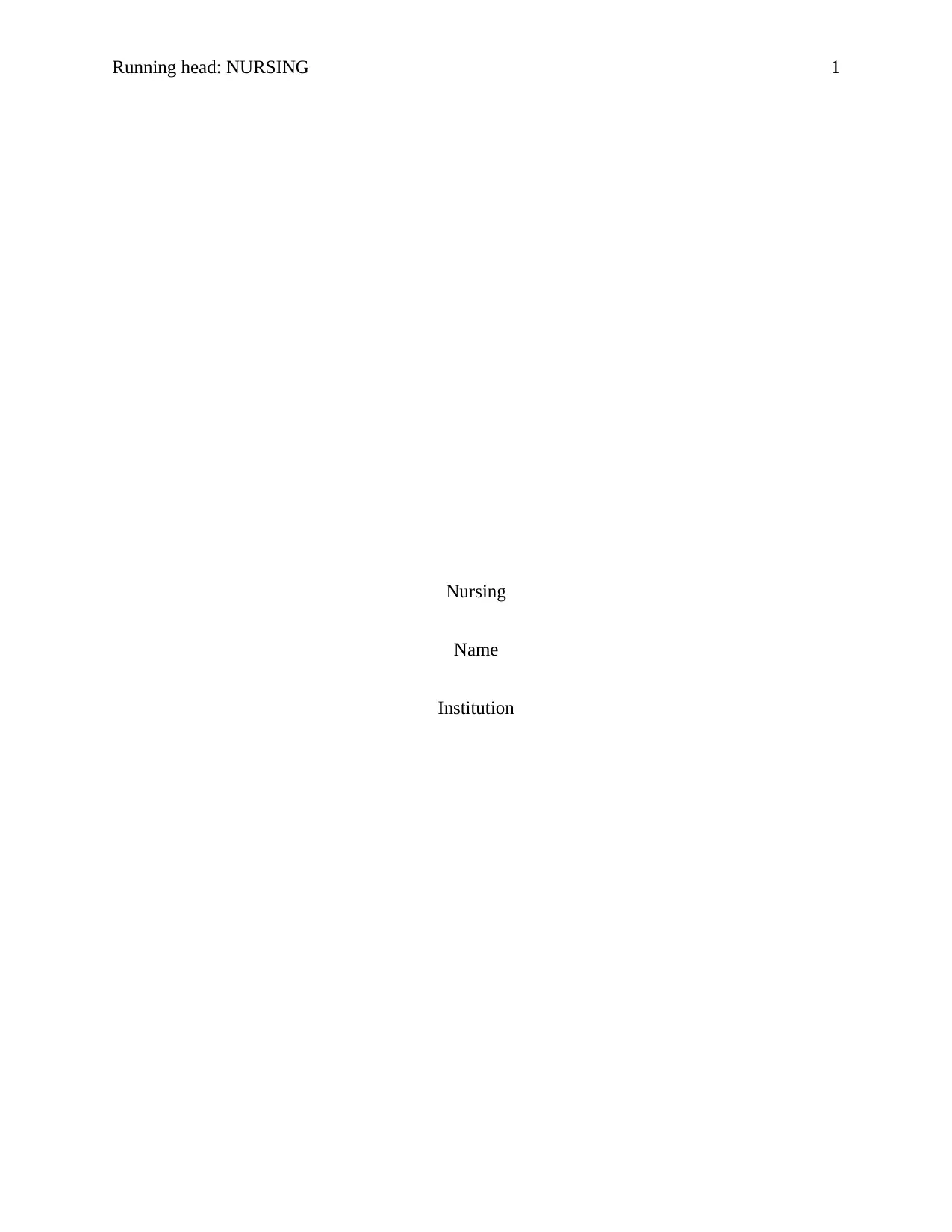
Running head: NURSING 1
Nursing
Name
Institution
Nursing
Name
Institution
Secure Best Marks with AI Grader
Need help grading? Try our AI Grader for instant feedback on your assignments.
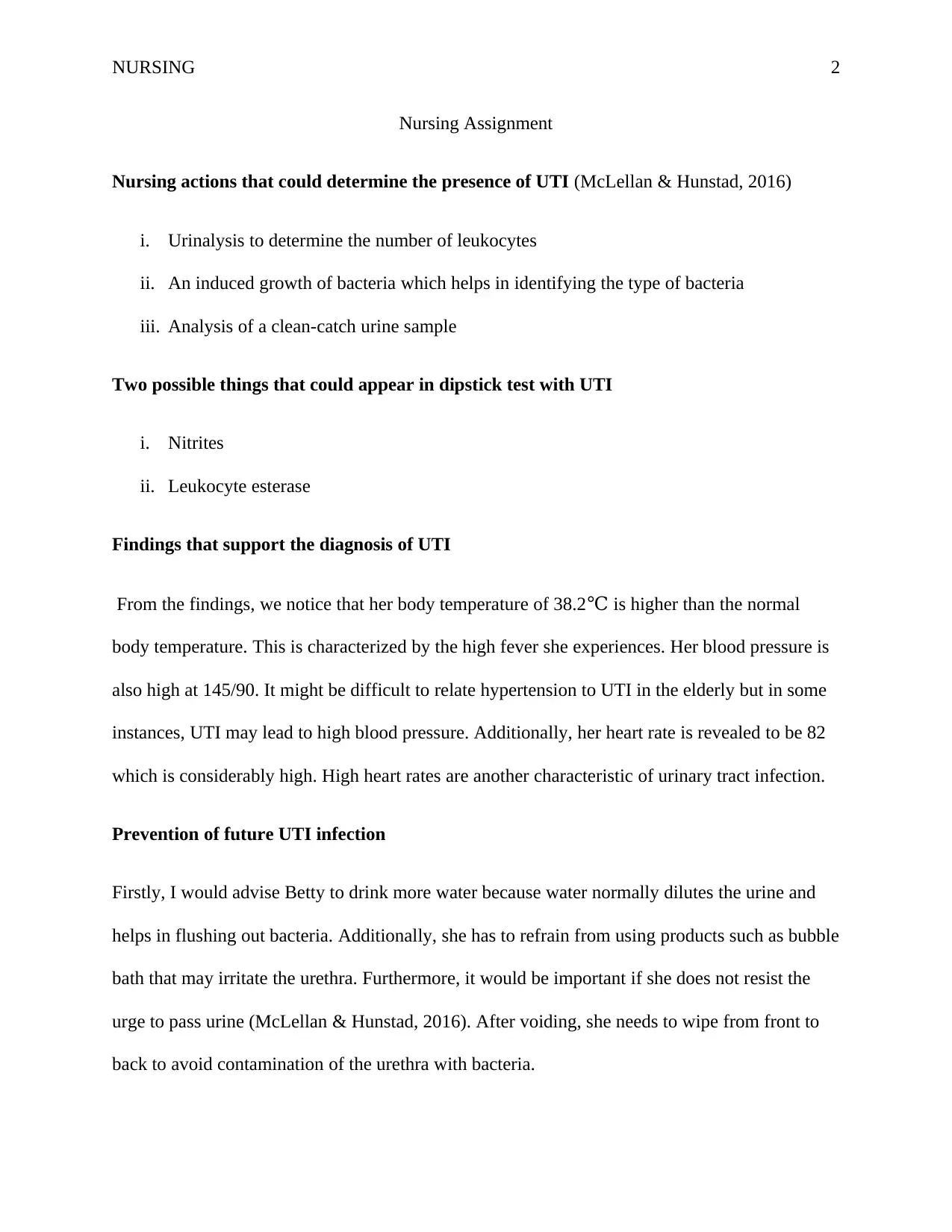
NURSING 2
Nursing Assignment
Nursing actions that could determine the presence of UTI (McLellan & Hunstad, 2016)
i. Urinalysis to determine the number of leukocytes
ii. An induced growth of bacteria which helps in identifying the type of bacteria
iii. Analysis of a clean-catch urine sample
Two possible things that could appear in dipstick test with UTI
i. Nitrites
ii. Leukocyte esterase
Findings that support the diagnosis of UTI
From the findings, we notice that her body temperature of 38.2℃ is higher than the normal
body temperature. This is characterized by the high fever she experiences. Her blood pressure is
also high at 145/90. It might be difficult to relate hypertension to UTI in the elderly but in some
instances, UTI may lead to high blood pressure. Additionally, her heart rate is revealed to be 82
which is considerably high. High heart rates are another characteristic of urinary tract infection.
Prevention of future UTI infection
Firstly, I would advise Betty to drink more water because water normally dilutes the urine and
helps in flushing out bacteria. Additionally, she has to refrain from using products such as bubble
bath that may irritate the urethra. Furthermore, it would be important if she does not resist the
urge to pass urine (McLellan & Hunstad, 2016). After voiding, she needs to wipe from front to
back to avoid contamination of the urethra with bacteria.
Nursing Assignment
Nursing actions that could determine the presence of UTI (McLellan & Hunstad, 2016)
i. Urinalysis to determine the number of leukocytes
ii. An induced growth of bacteria which helps in identifying the type of bacteria
iii. Analysis of a clean-catch urine sample
Two possible things that could appear in dipstick test with UTI
i. Nitrites
ii. Leukocyte esterase
Findings that support the diagnosis of UTI
From the findings, we notice that her body temperature of 38.2℃ is higher than the normal
body temperature. This is characterized by the high fever she experiences. Her blood pressure is
also high at 145/90. It might be difficult to relate hypertension to UTI in the elderly but in some
instances, UTI may lead to high blood pressure. Additionally, her heart rate is revealed to be 82
which is considerably high. High heart rates are another characteristic of urinary tract infection.
Prevention of future UTI infection
Firstly, I would advise Betty to drink more water because water normally dilutes the urine and
helps in flushing out bacteria. Additionally, she has to refrain from using products such as bubble
bath that may irritate the urethra. Furthermore, it would be important if she does not resist the
urge to pass urine (McLellan & Hunstad, 2016). After voiding, she needs to wipe from front to
back to avoid contamination of the urethra with bacteria.
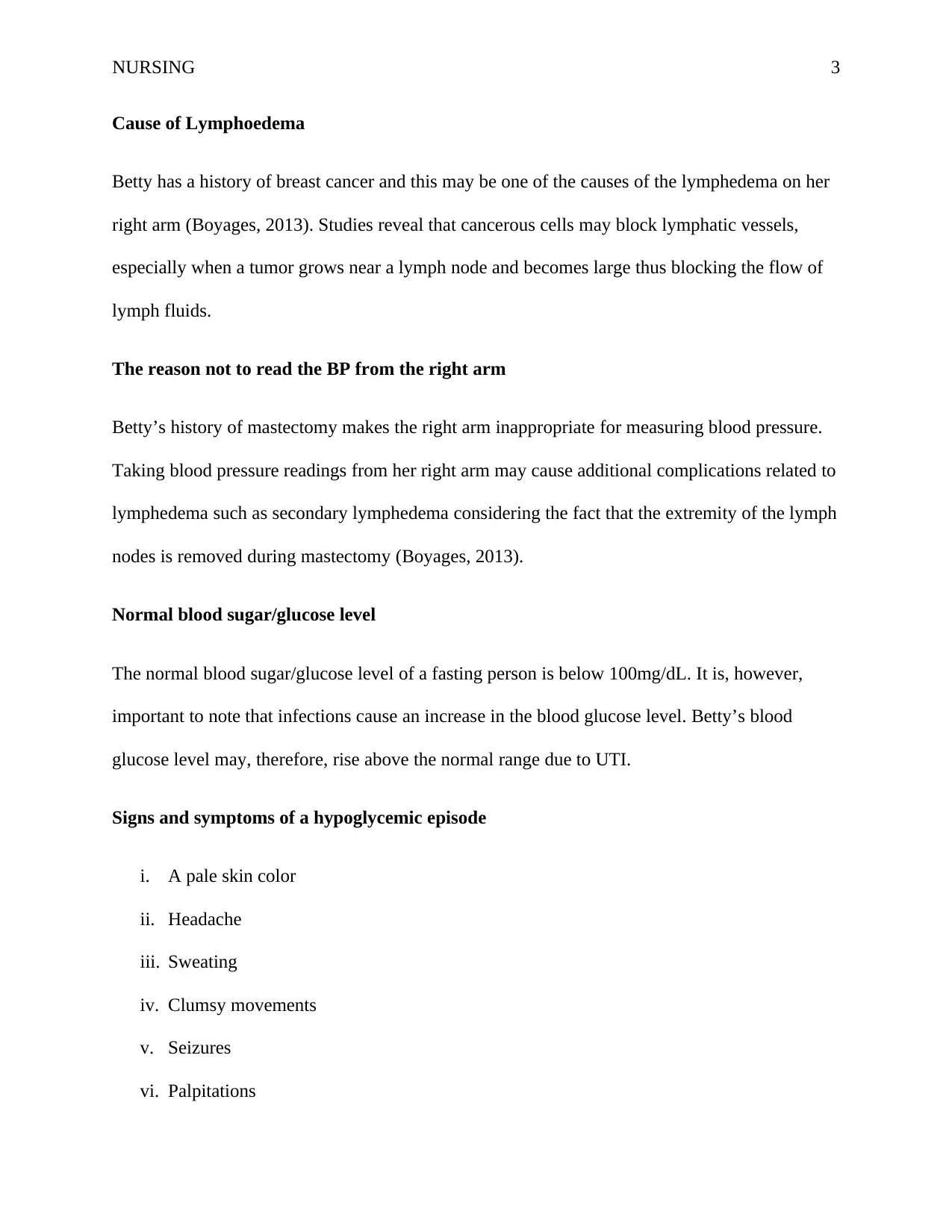
NURSING 3
Cause of Lymphoedema
Betty has a history of breast cancer and this may be one of the causes of the lymphedema on her
right arm (Boyages, 2013). Studies reveal that cancerous cells may block lymphatic vessels,
especially when a tumor grows near a lymph node and becomes large thus blocking the flow of
lymph fluids.
The reason not to read the BP from the right arm
Betty’s history of mastectomy makes the right arm inappropriate for measuring blood pressure.
Taking blood pressure readings from her right arm may cause additional complications related to
lymphedema such as secondary lymphedema considering the fact that the extremity of the lymph
nodes is removed during mastectomy (Boyages, 2013).
Normal blood sugar/glucose level
The normal blood sugar/glucose level of a fasting person is below 100mg/dL. It is, however,
important to note that infections cause an increase in the blood glucose level. Betty’s blood
glucose level may, therefore, rise above the normal range due to UTI.
Signs and symptoms of a hypoglycemic episode
i. A pale skin color
ii. Headache
iii. Sweating
iv. Clumsy movements
v. Seizures
vi. Palpitations
Cause of Lymphoedema
Betty has a history of breast cancer and this may be one of the causes of the lymphedema on her
right arm (Boyages, 2013). Studies reveal that cancerous cells may block lymphatic vessels,
especially when a tumor grows near a lymph node and becomes large thus blocking the flow of
lymph fluids.
The reason not to read the BP from the right arm
Betty’s history of mastectomy makes the right arm inappropriate for measuring blood pressure.
Taking blood pressure readings from her right arm may cause additional complications related to
lymphedema such as secondary lymphedema considering the fact that the extremity of the lymph
nodes is removed during mastectomy (Boyages, 2013).
Normal blood sugar/glucose level
The normal blood sugar/glucose level of a fasting person is below 100mg/dL. It is, however,
important to note that infections cause an increase in the blood glucose level. Betty’s blood
glucose level may, therefore, rise above the normal range due to UTI.
Signs and symptoms of a hypoglycemic episode
i. A pale skin color
ii. Headache
iii. Sweating
iv. Clumsy movements
v. Seizures
vi. Palpitations

NURSING 4
vii. Confusions and a difficulty in paying attention
Pathophysiology of type 2 diabetes
Type 2 diabetes results from the inability of the pancreas to produce enough insulin or the
resistance of the body to insulin (Goldstein & Müller-Wieland, 2013). This condition leads to an
increase in the blood glucose level thus leading to a reduction in the glycogen stores which in
turn leads to reduced availability of glucose when the need arises.
Difference between type 1 and type 2 diabetes
The main difference between these two types of diabetes is that people with type 1 diabetes do
not produce insulin while people with type 2 diabetes do not respond to insulin appropriately. In
the later stages of type 2, the patient does not produce adequate insulin.
Effect of type 2 diabetes on healing wounds
Diabetes reduces the rate at which wounds heal by through the impairment of blood circulation
to the regions with wounds. This impairment is due to the fact that diabetes may narrow the
arteries that carry blood to different parts of the body thus limiting the amount of fresh blood that
gains access to the wounds (Goldstein & Müller-Wieland, 2013). If this condition is not
addressed soon enough the wounds may develop into deep sores.
HbA1c
HbA1c occurs when hemoglobin joins with glucose in the blood to form ‘glycated’ hemoglobin.
An increase in HbA1 in the past three months is an indication of an increasing blood glucose
level.
vii. Confusions and a difficulty in paying attention
Pathophysiology of type 2 diabetes
Type 2 diabetes results from the inability of the pancreas to produce enough insulin or the
resistance of the body to insulin (Goldstein & Müller-Wieland, 2013). This condition leads to an
increase in the blood glucose level thus leading to a reduction in the glycogen stores which in
turn leads to reduced availability of glucose when the need arises.
Difference between type 1 and type 2 diabetes
The main difference between these two types of diabetes is that people with type 1 diabetes do
not produce insulin while people with type 2 diabetes do not respond to insulin appropriately. In
the later stages of type 2, the patient does not produce adequate insulin.
Effect of type 2 diabetes on healing wounds
Diabetes reduces the rate at which wounds heal by through the impairment of blood circulation
to the regions with wounds. This impairment is due to the fact that diabetes may narrow the
arteries that carry blood to different parts of the body thus limiting the amount of fresh blood that
gains access to the wounds (Goldstein & Müller-Wieland, 2013). If this condition is not
addressed soon enough the wounds may develop into deep sores.
HbA1c
HbA1c occurs when hemoglobin joins with glucose in the blood to form ‘glycated’ hemoglobin.
An increase in HbA1 in the past three months is an indication of an increasing blood glucose
level.
Secure Best Marks with AI Grader
Need help grading? Try our AI Grader for instant feedback on your assignments.
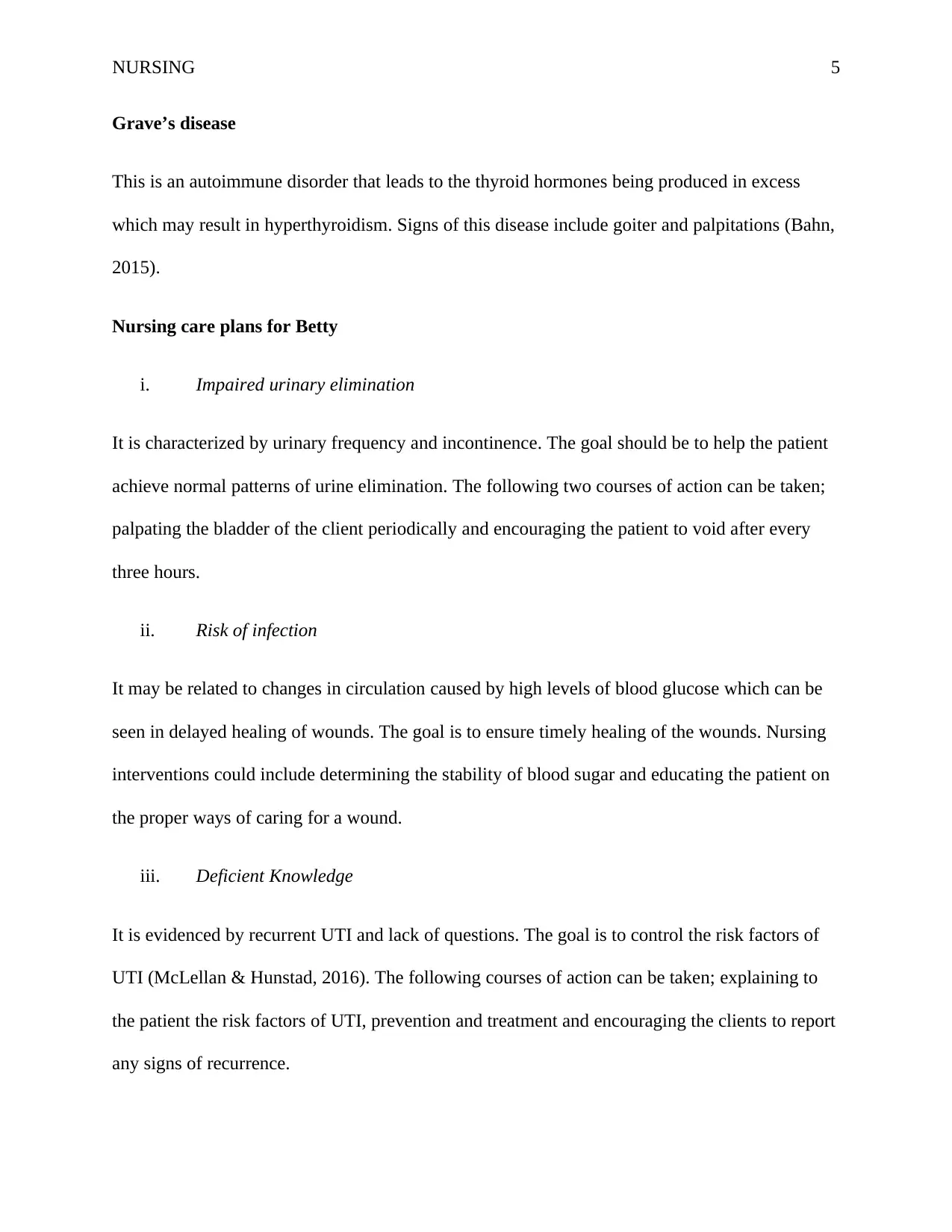
NURSING 5
Grave’s disease
This is an autoimmune disorder that leads to the thyroid hormones being produced in excess
which may result in hyperthyroidism. Signs of this disease include goiter and palpitations (Bahn,
2015).
Nursing care plans for Betty
i. Impaired urinary elimination
It is characterized by urinary frequency and incontinence. The goal should be to help the patient
achieve normal patterns of urine elimination. The following two courses of action can be taken;
palpating the bladder of the client periodically and encouraging the patient to void after every
three hours.
ii. Risk of infection
It may be related to changes in circulation caused by high levels of blood glucose which can be
seen in delayed healing of wounds. The goal is to ensure timely healing of the wounds. Nursing
interventions could include determining the stability of blood sugar and educating the patient on
the proper ways of caring for a wound.
iii. Deficient Knowledge
It is evidenced by recurrent UTI and lack of questions. The goal is to control the risk factors of
UTI (McLellan & Hunstad, 2016). The following courses of action can be taken; explaining to
the patient the risk factors of UTI, prevention and treatment and encouraging the clients to report
any signs of recurrence.
Grave’s disease
This is an autoimmune disorder that leads to the thyroid hormones being produced in excess
which may result in hyperthyroidism. Signs of this disease include goiter and palpitations (Bahn,
2015).
Nursing care plans for Betty
i. Impaired urinary elimination
It is characterized by urinary frequency and incontinence. The goal should be to help the patient
achieve normal patterns of urine elimination. The following two courses of action can be taken;
palpating the bladder of the client periodically and encouraging the patient to void after every
three hours.
ii. Risk of infection
It may be related to changes in circulation caused by high levels of blood glucose which can be
seen in delayed healing of wounds. The goal is to ensure timely healing of the wounds. Nursing
interventions could include determining the stability of blood sugar and educating the patient on
the proper ways of caring for a wound.
iii. Deficient Knowledge
It is evidenced by recurrent UTI and lack of questions. The goal is to control the risk factors of
UTI (McLellan & Hunstad, 2016). The following courses of action can be taken; explaining to
the patient the risk factors of UTI, prevention and treatment and encouraging the clients to report
any signs of recurrence.
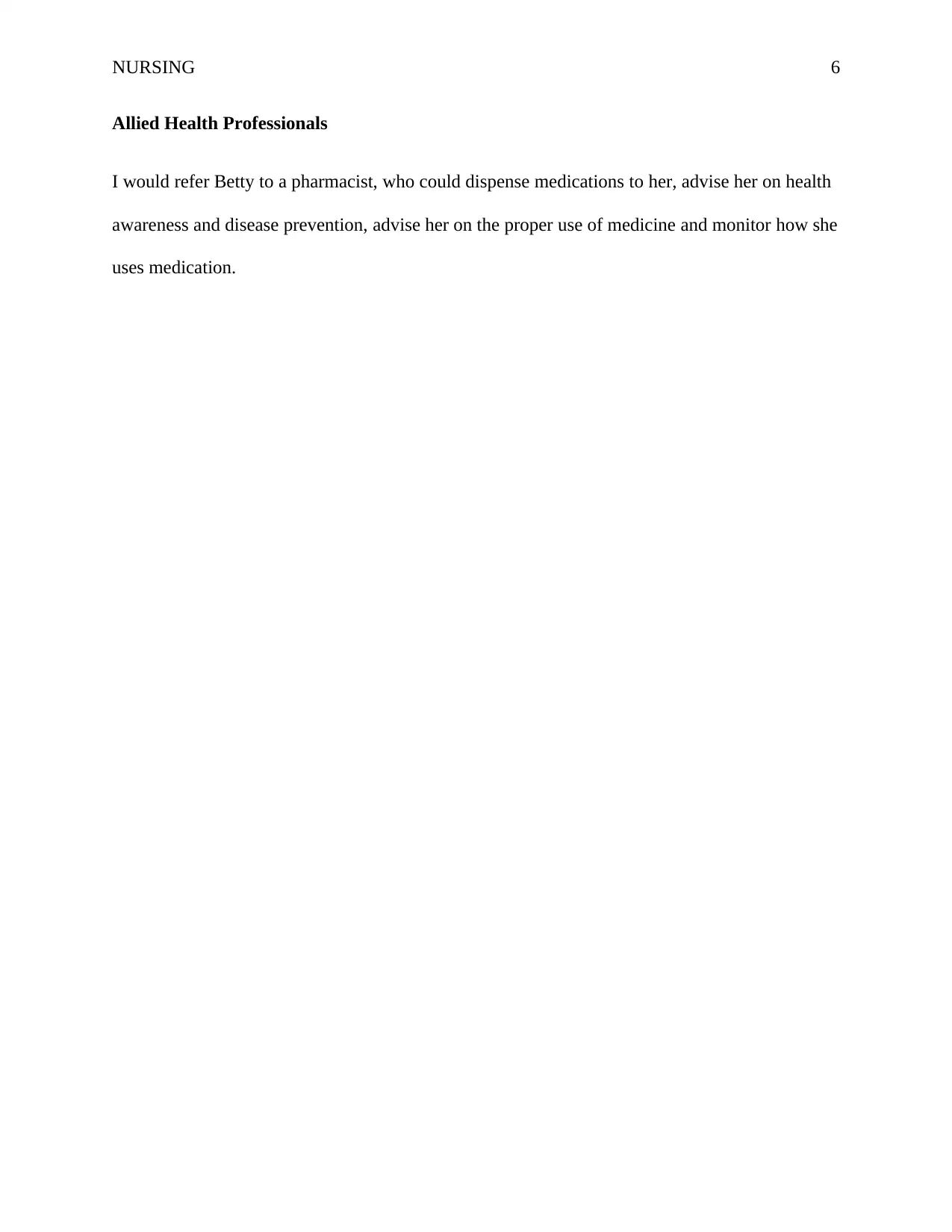
NURSING 6
Allied Health Professionals
I would refer Betty to a pharmacist, who could dispense medications to her, advise her on health
awareness and disease prevention, advise her on the proper use of medicine and monitor how she
uses medication.
Allied Health Professionals
I would refer Betty to a pharmacist, who could dispense medications to her, advise her on health
awareness and disease prevention, advise her on the proper use of medicine and monitor how she
uses medication.
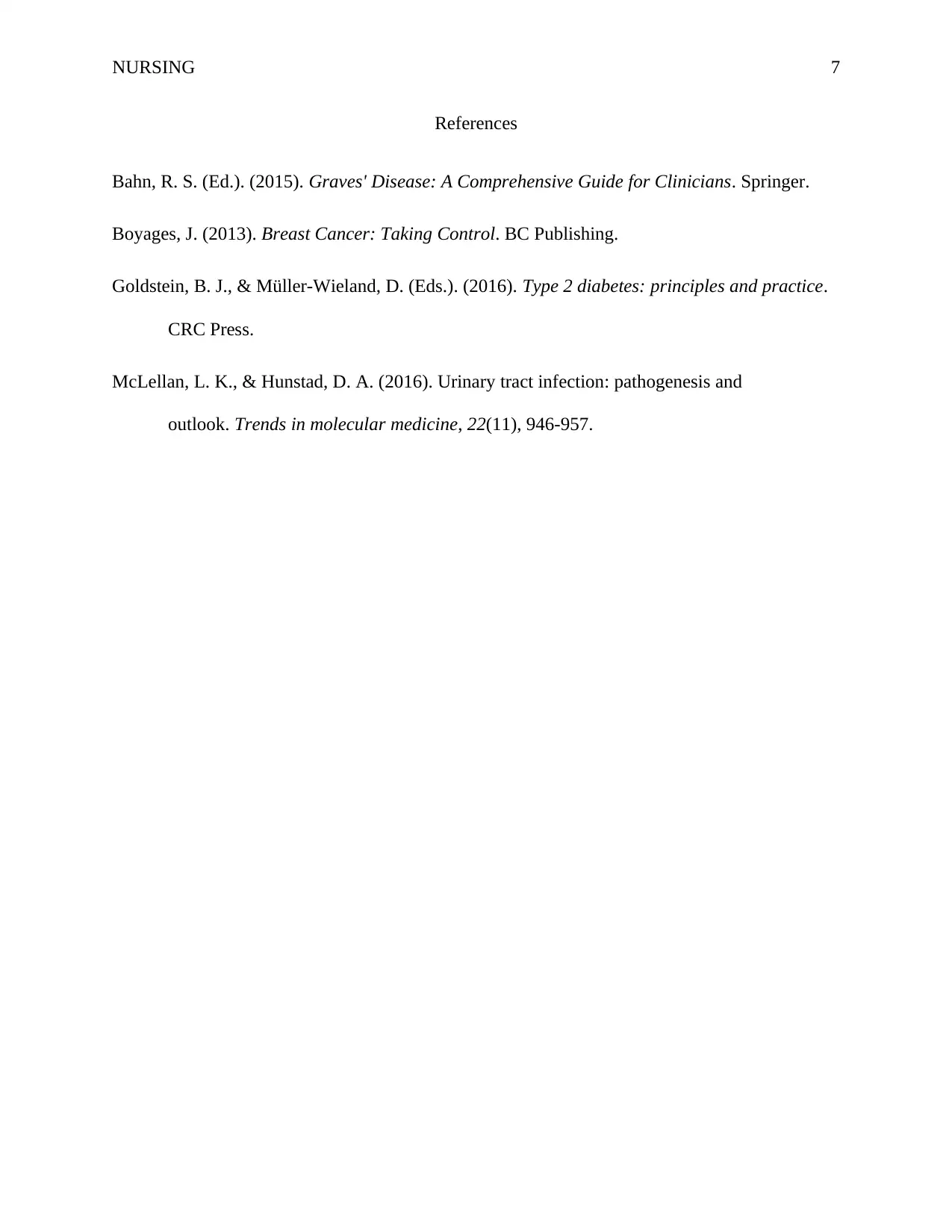
NURSING 7
References
Bahn, R. S. (Ed.). (2015). Graves' Disease: A Comprehensive Guide for Clinicians. Springer.
Boyages, J. (2013). Breast Cancer: Taking Control. BC Publishing.
Goldstein, B. J., & Müller-Wieland, D. (Eds.). (2016). Type 2 diabetes: principles and practice.
CRC Press.
McLellan, L. K., & Hunstad, D. A. (2016). Urinary tract infection: pathogenesis and
outlook. Trends in molecular medicine, 22(11), 946-957.
References
Bahn, R. S. (Ed.). (2015). Graves' Disease: A Comprehensive Guide for Clinicians. Springer.
Boyages, J. (2013). Breast Cancer: Taking Control. BC Publishing.
Goldstein, B. J., & Müller-Wieland, D. (Eds.). (2016). Type 2 diabetes: principles and practice.
CRC Press.
McLellan, L. K., & Hunstad, D. A. (2016). Urinary tract infection: pathogenesis and
outlook. Trends in molecular medicine, 22(11), 946-957.
1 out of 7
Your All-in-One AI-Powered Toolkit for Academic Success.
+13062052269
info@desklib.com
Available 24*7 on WhatsApp / Email
![[object Object]](/_next/static/media/star-bottom.7253800d.svg)
Unlock your academic potential
© 2024 | Zucol Services PVT LTD | All rights reserved.


